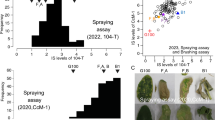Abstract
Genetic diversity analysis was conducted on a set of 20 sorghum [Sorghum bicolor (L.) Moench] cultivars having resistance to shootfly (Atherigona soccata Rond.), originating from different geographic regions, and representing different taxonomic groups. The genetic diversity for shootfly resistance was assessed using multivariate analysis (D2 statistic and canonical variate analysis), and geographic/taxonomic divergence. The grouping of cultivars based on genetic divergence was found more accurate and relevant than that based on either geographic or taxonomic divergence. Both D2 and canonical variate analyses gave very similiar clustering patterns over the years analysed. Trichome density contributed mainly toward genetic divergence in shootfly resistance, followed by glossiness. Based on the presence or absence of these traits, the cultivars resistant to shootfly were classified into four major clusters. Resistant cultivars IS 844 and IS 1054 formed separate clusters over the years. Heterosis for shootfly resistance was found associated with genetic divergence but not with geographic or taxonomic divergence.
Résumé
L’analyse de la diversité génétique a été effectuée sur 20 cultivars de sorgho (Sorghum bicolor (L.) Moench) présentant la résistance à la mouche des pousses (Atherigona soccata Rond.). Ces souches ont été prises de régions géographiques différentes et ont représenté des groupes taxonomiques différents. La diversité génétique pour la résistance à la mouche des pousses a été évaluée à l’aide de l’analyse à plusieurs variables (analyse statistique D2 et analyse variable “D2 statistic and canonical variate analysis” et en utilisant la divergence géographique/taxonomique. On a trouvé que le groupement des cultivars basé sur la divergence génétique était plus précis et pertinent que celui basé sur la divergence géographique ou taxonomique. L’analyse D2 et l’analyse variable ont toutes les deux mis en évidence des configurations de grappe très identiques sur les années analysées. La divergence génétique chez la résistance à la mouche des pousses a été due principalement à la densité des trichomes, suivie du caractère vernissé. Des cultivars résistants à la mouche des pousses ont été classés en quatre grappes principales selon la présence ou l’absence de ces traits. Au cours des années, les sources résistantes IS 844 et IS 1054 ont formé des grappes séparées. Les résultats ont mis en évidence que l’hétérosis pour la résistance à la mouche des pousses est liée à la divergence génétique, et non à la divergence géographique ou taxonomique.
Similar content being viewed by others
References
Arunachalam V. and Jawahar Ram (1967) Geographical diversity in relation to genetic divergence in cultivated sorghum. Indian J. Genet. 27, 369–380.
Chandrasekharaiah S. R., Murthy B. R. and Arunachalam V. (1969) Multivariate analysis of divergence in Eu-sorghum. Nat. Inst. Sci., India Bull. 35, 172–195.
Maiti R. K. and Bidinger F. R. (1979) A simple approach to the identification of shootfly tolerance in sorghum. Indian J. Plant Prot. 7, 135–140.
Maiti R. K., Seshu Reddy K. V., Gibson P. and Davies J. C. (1980) Nature and occurrence of trichomes in sorghum lines with resistance to the sorghum shootfly. In Joint Progress Report, Sorghum Physiology—3, Sorghum Entomology—3. Patancheru, A.P. 502 324, India. International Crops Research Institute for the Semi-Arid Tropics (Limited distribution).
Malm N. B. (1968) Exotic germplasm use in grain sorghum improvement. Crop Sci. 8, 295–298.
Murthy B. R. and Arunachalam V. (1966) The nature of divergence in relation to breeding systems in some crop plants. Indian J. Genet. 26, 188–198.
Niehaus M. H. and Pickett R. C (1966) Heterosis and combining ability in a diallel cross in Sorghum vulgare Pers.. Crop Sci. 6, 33–36.
Omori T., Agrawal B. L. and House L. R. (1983) Componental analysis of the factors influencing shootfly resistance in sorghum [Sorghum bicolor (L.] Moench]. Japanese Agric. Res. Q. 17, 215–218.
Panse V. G. and Sukhatme P. V. (1967) Statistical Methods for Agricultural Workers. Indian Council of Agricultural Research, New Delhi.
Rao C. R. (1952) Advanced Statistical Methods in Biométrie Research. John Wiley and Sons, New Delhi.
Rao N. G. P. (1962) Occurrence of cytoplasmic genetic male-sterility in some Indian sorghums. Indian J. Genet. 22, 257–259.
Stārks K. J. (1970) Increasing infestation of the sorghum shootfly in experimental plot. J. Econ. Ent. 63, 1715.
Subba Rao G. S., Jagadish C. A. and House L. R. (1975) Combining ability studies in sorghum. I. American and African crosses. Indian J. Hered. 7, 5–11.
Subba Rao G. S., Jagadish C. A. and House L. R. (1976) Combining ability studies in Indian × exotic crosses of sorghum. Indian J. Hered. 8, 21–38.
Author information
Authors and Affiliations
Rights and permissions
About this article
Cite this article
Omori, T., Agrawal, B.L. & House, L.R. Genetic Divergence for Resistance to Shootfly, Atherigona soccata Rond. in Sorghum, Sorghum bicolor (L.) Moench and its Relationship with Heterosis. Int J Trop Insect Sci 9, 483–488 (1988). https://doi.org/10.1017/S1742758400011000
Received:
Revised:
Published:
Issue Date:
DOI: https://doi.org/10.1017/S1742758400011000




